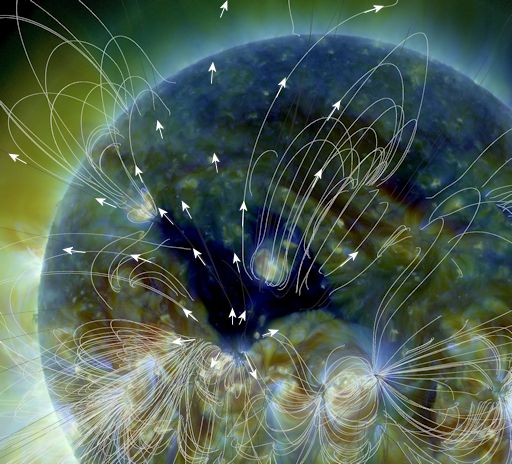SUBSIDING PROTONS, MORE TO COME? Energetic protons are swarming past Earth in the aftermath of a magnetic explosion on the sun's western limb on Dec. 28th: movie. At its peak, the radiation storm registered "S1" on NOAA storm scales, which is to say it was a minor event with minimal effects on Earth-orbiting satellites and aviation. The storm is subsiding now. Stronger radiation storms are possible in the days ahead, however, as potent sunspot AR1934 rotates toward the western limb--a place with a strong magnetic connection to Earth. Flares from AR1934 could send more protons in our direction. Solar flare alerts: text, voice.
COMING SOON--THE FIRST AURORAS OF 2014: Magnetic fields in the sun's northern hemisphere have opened up, creating a vast hole in the sun's atmosphere--a coronal hole. NASA's Solar Dynamics Observatory is monitoring the UV-dark gap:
Coronal holes are places where magnetic fields threading through the sun's atmosphere spread apart and allow solar wind to escape. A stream of solar wind flowing from this particular coronal hole could reach Earth on Jan. 2-3, possibly sparking polar geomagnetic storms. The first auroras of 2014 are in the offing. Solar flare alerts: text, voice.

Solar wind
speed: 347.7 km/sec
density: 0.4 protons/cm3
explanation | more data
Updated: Today at 1717 UT
X-ray Solar Flares
6-hr max: C2 1643 UT Dec30
24-hr: C2 1643 UT Dec30
explanation | more data
Updated: Today at: 1700 UT
![]()
Daily Sun: 30 Dec 13
Sunspots AR1934 and AR1936 have complex magnetic fields that harbor energy for M- and X-class solar flares. Credit: SDO/HMI
![]()
Sunspot number: 119
What is the sunspot number?
Updated 30 Dec 2013
Spotless Days
Current Stretch: 0 days
2013 total: 0 days (0%)
2012 total: 0 days (0%)
2011 total: 2 days (<1%)
2010 total: 51 days (14%)
2009 total: 260 days (71%)
Since 2004: 821 days
Typical Solar Min: 486 days
Update 30 Dec 2013
The Radio Sun
10.7 cm flux: 137 sfu
explanation | more data
Updated 30 Dec 2013
![]()
Current Auroral Oval:
Switch to: Europe, USA, New Zealand, Antarctica
Credit: NOAA/POES
![]()
Planetary K-index
Now: Kp= 1 quiet
24-hr max: Kp= 2 quiet
explanation | more data
Interplanetary Mag. Field
Btotal: 6.1 nT
Bz: 2.7 nT north
explanation | more data
Updated: Today at 1717 UT
![]()
Coronal Holes: 30 Dec 13
Solar wind flowing from the indicated coronal hole could reach Earth on Jan 2-3. Credit: SDO/AIA.





